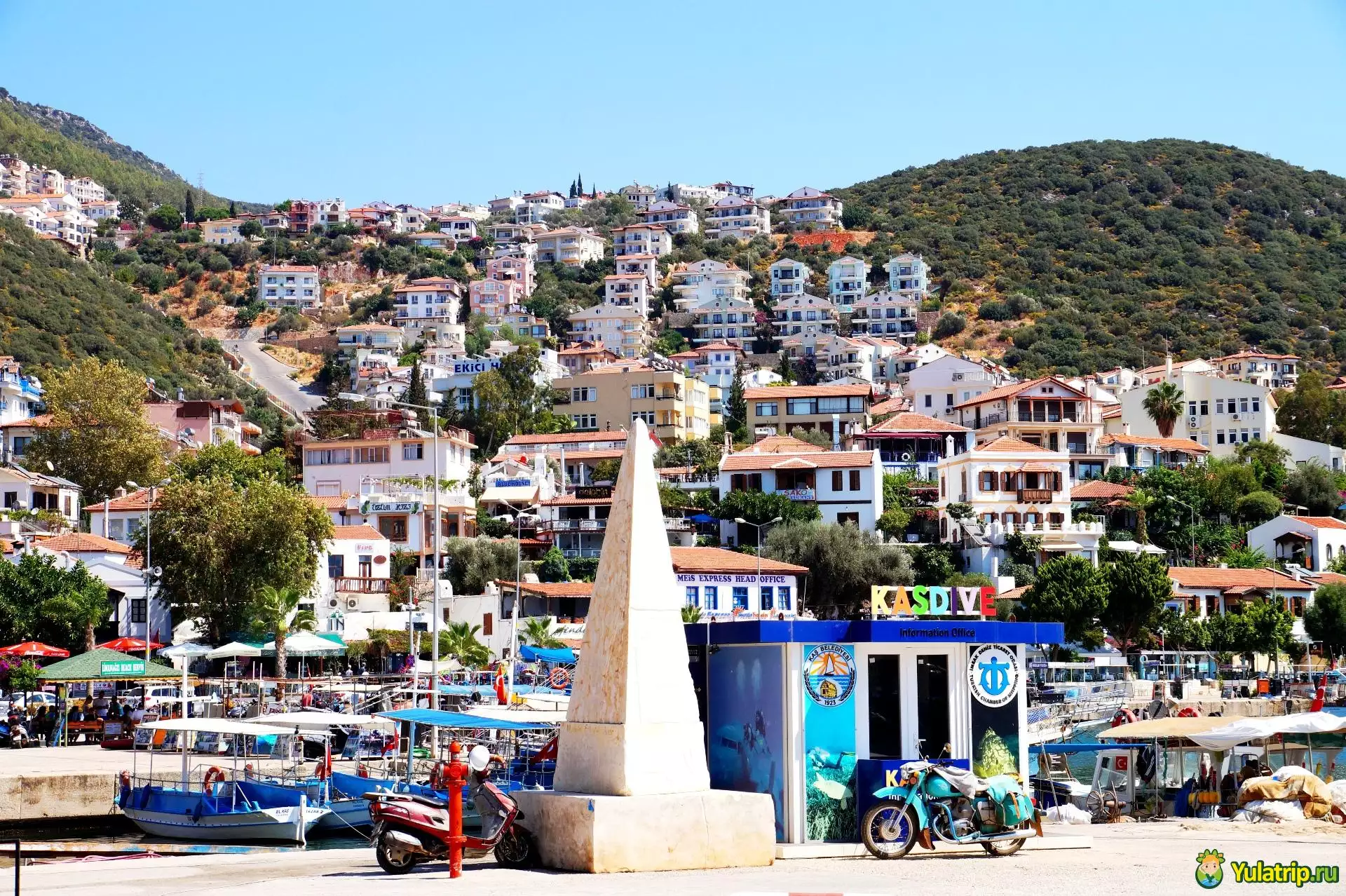Kash that Antiphellos. Description and characterization.

Kaş is a small seaside town located in the southwestern part of Turkey on the coast of Antalya. Kas is surrounded on all sides by beautiful mountains, descending to the sea. The western European part of the town is a peninsula covered with greenery and flowers. Resort visitors are attracted by the cleanest sandy beaches and wild nature.
Despite the fact that Kaş belongs to the most fashionable resorts of the “Turkish Riviera”. It has long felt a significantly smaller influx of vacationers than other tourist towns in the area. That is why it is a favorite among the adorers of quiet family vacations and extreme sports. In Kasha there are all conditions for diving, yachting, deep-sea fishing.

Where is Kash?
The closest airport to the town is the airportDalaman(150 km - about 3 hours) and Antalya (185 km). They are connected to Kaş by suburban flights. There is a stable passenger bus service between Kaş and Antalya.IzmirIstanbul, Ankara. These trips are realized, as a rule, at night. Therefore, despite the long travel time, they are not exhausting for passengers.
Is it hot in Kasha?
Kaş is influenced by the Mediterranean climate with warm, humid winters and hot summers. The tourist season starts in early April, when the water in the sea heats up to +21 -23°C. It ends at the end of August. It ends at the end of August. From September comes the “velvet” season, which lasts until mid-November. At this time, the air temperature drops to +28°C, while the water temperature remains at the same level. The hottest months are July and August, when the thermometer column rises to +34°C. High mountains shield Kash from cold winds, so even in winter the temperature does not fall below +10°C.

A brief history of Kash.
In Turkish, Kaş means “eyebrow” and in fact, from a bird's eye view, the town takes on the configuration of an arched eyebrow. Kash has an ancient history. It was built in the IV century BC by the Hellenes, as part of the ancient settlement of Fellos, standing on the back side of the bay. Due to its location, it acquired the name Antiphellos, which translates as “opposite Fellos”.
The results of the findings show that the ancient Antiphellos was a tiny place, the number of inhabitants in which did not exceed the population of the present Kash (nowadays the town has about 5 thousand people). In ancient Greek times it played the function of a transportation port between the big cities of the Mediterranean coast. Antiphellos reached its apotheosis during the Hellenic rule.
29 September 2025
9 October 2024
9 October 2024
Middle Ages - the town fell under the rule of the Arabs and later the Seljuk and Ottoman Turks. In 1852, the town was renamed Andifli. At that time, the main part of its inhabitants were emigrants from Greece. And in 1923 the Hellenes left the town, returning to their homeland. In the same year it was renamed to Kash.

What to see in Cacha.
There are not many attractions in Kasha, but this is fully compensated for by the large number of historical and cultural monuments. During a trip to Kasha, it is worth seeing the small ancient Greek theater, which has only 26 rows. Not far from the theater you can see one more remarkable thing. It is a necropolis hollowed out in the cliff, dating back to the 4th century BC. Those who are intrigued by the mystery of the ancient burials can go to the northern half of the city. There are some strikingly attractive stony tombs. A specific attribute of Kash is the sarcophagus of Hypsorion, dating back to the 4th century BC. It can be recognized by the granite lion heads decorating the corners of the sarcophagus. Also on its surface can be seen engravings in Lycian language.
Among the natural monuments, Saklikent Canyon and the caves of Mawi-Magar and Güverjin are worth visiting. However, it should be borne in mind that these caves can be reached only by swimming. The ruins of the ancient Greek villages of Xanthos and Komba, located in the vicinity of the city, are also of great interest.

Are there any beaches in Kasha?
In Kaşa, the beaches are located outside the town, but any of them can be reached on foot. The closest is Kucuk Cakil, which is set in a beautiful plain among the cliffs. Two kilometers away from it is Buyuk Cakil. A little farther away is Kaputas, famous for its cleanliness and the beauty of the deep sea.
For connoisseurs of boat trips, a yacht tour is offered along the coast and around the surrounding islands. For divers, Kaş is a true Eden. Here you can try to find the riches of the sunken town and swim in the underwater crevices. Alternatively, you can take a trip in off-road vehicles or a cable car along the Saklykent Gorge.
Liked the article - don't forget to share it with your friends!!!
See you all again on Hata Matata.
Comment
Popular Posts
29 September 2025
393
9 October 2024
1487
9 October 2024
9943
Popular Offers

Subscribe to the newsletter from Hatamatata.com!
Subscribe to the newsletter from Hatamatata.com!
I agree to the processing of personal data and confidentiality rules of Hatamatata














